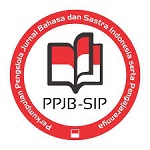SUMBANGAN BAHASA INDONESIA TERHADAP PENGENDALIAN COVID-19
DOI:
https://doi.org/10.22460/semantik.v9i2.p59-76Keywords:
Covid-19, Pragmasemantic, Language Functions, Speech ActsAbstract
This research is a descriptive qualitative research with the approach of Pragmasemantic theory and Speech Act theory. Pragmasemantic theory is basically a theory used to study the use of language based on meanings that take into account the intralingual and extralingual contexts. Mean while, speech act theory is essentially a theory that wants to explain that each utterance always contains three elements, namely locution, illocution, and perlocution. The purpose of this study is (a) to describe the language functions that can be used to campaign for Covid-19 deployment control, (b) describe vocabulary that has touch power and can be used to campaign for Covid-19 deployment control, (c) describe language slogans that can used to campaign for Covid-19 deployment control, and (d) describe persuasive language forms that can be used to campaign for Covid-19 deployment control. Research data sources are students of the Indonesian Language and Literature Education Study Program, S1 and S2 programs which can be reached via online media, email or WA. Research data in the form of words, phrases, sentences that show the function of language, vocabulary that has the power of touch, slogans that can encourage, persuasive language that can persuade speech partners compiled by students. Data collection techniques are carried out by sending instruments via email or WA, then students are asked to fill out and send back to researchers. The collected data is then inventoryed and codified to determine incoming data that is suitable for analysis. The analysis techniques are (1) identifying data, (b) classifying data, (c) interpreting data with the intention of being able to interpret Covid-19 ways of controlling, and (d) preparing reports in the form of journal articles.References
Arini, A. D. (2012). Bentuk, Makna, Dan Fungsi Bahasa Tulis Media Sosial Sebagai Alat Komunikasi Dan Interaksi Pada Internet. ISkriptorium, 2(4), 293–299. https://doi.org/10.5034/inquiryjrnl_49.04.09.
Austin, J. L. (1962a). How to Do Things with Words. OXFORD AT THE CLARENDON PRESS.
Austin, J. L. (1962b). How to Do Thngs With Words. Oxford University Press, PRINTED IN GREAT BRITAIN.
Brown, G., & Yule, G. (2013). Introduction: linguistic forms and functions. In Discourse Analysis. https://doi.org/10.1017/cbo9780511805226.003
Buana, D. R. (2020). Pnemonia Covid-19. Diagnosis & Penatalaksanaan di Indonesia.
Cahyono A.S. (2016). PENGARUH MEDIA SOSIAL TERHADAP PERUBAHAN SOSIAL MASYARAKAT DI INDONESIA. Jurnal Publiciana, 9 (1).140-157.
Cook, G. (2003). Applied Linguistics (Oxford Introduction to Language Study Series). Oxfords.
Hanana, A., Elian, N., & Marta, R. (2017). Strategi Komunikasi Persuasif Dalam Menciptakan Masyarakat Sadar Wisata Di Kawasan Wisata Pantai Padang, Kota Padang. Jurnal Ilmu Sosial Mamangan, 6(1), 34-46.
Harista, E. (2018). Pengunaan Bahasa Persuasi di Media Sosial dalam Berdakwah pada Akun Facebook ‘Yusuf Mansur (Official).’ Mawa’Izh: Jurnal Dakwah Dan Pengembangan Sosial Kemanusiaan, 8(2), 308–324. https://doi.org/10.32923/maw.v8i2.778
Kaburise, P. (2012). Recognising Speech Acts. Per Linguam, 28(1), 36–48. https://doi.org/10.5785/28-1-118
Marnetti, M. (2017). Analisis Gaya Bahasa Dalam Slogan Lingkungan Hidup. Madah: Jurnal Bahasa Dan Sastra, 8(1), 87. https://doi.org/10.31503/madah.v8i1.465
Mihail, G. C. (2017). The Pragmasemantic Analysis of the Correspondence between Mircea Eliade and Ioan Petru Culianu: The Proof of Unconditional Devotion and Circularity of Literary and Ontological Perspectives between the Master and the Disciple. Acta Universitatis Danubius, 11(1), 102–115. Retrieved from http://jurnal.ustjogja.ac.id/index.php/caraka/article/view/3179
Murdowo, S. (2007). IMAJINASI SEBAGAI ROH KREATIF INTELEK DALAM PROSES KREASI PENCIPTAAN KARYA SENI. Imajinasi, Vol.5, No., 205–214.
Nisa’, K. (2017). TUTURAN AMBIGUITAS DALAM WACANA HUMOR WAKTU INDONESIA BERCANDA: KAJIAN PRAGMASEMANTIK. PRASASTI: Journal of Linguistics, 2(2), 300. https://doi.org/10.20961/prasasti.v2i2.8394
Nurrizka, A. F. (2016). Peran Media Sosial di Era Globalisasi Pada Remaja di Surakarta Suatu Kajian Teoritis dan Praktis Terhadap Remaja dalam Perspektif Perubahan Sosial. Jurnal Analisa Sosiologi, 51 (28), 28–37.
Pertiwi, D. (2018). STRATEGI KOMUNIKASI PERSUASIF DALAM MENINGKATKAN JUMLAH DEBITUR DI PT. BNI (PERSERO) TBK KANTOR CABANG PADANG. Jom Fisip, 5, 1–14.
Porayska-Pomsta, K., Mellish, C. S., & Pain, H. (2000). Pragmatic analysis of teachers’ language: Towards an empirically based approach. In Proc. of the AAAI Fall Symposium on Building Systems for Tutorial Applications.
Rahardi, R. K. (2005). Pragmatik: kesantunan imperatif bahasa Indonesia. Erlangga.
Ratnamulyani, I. A., & Maksudi, B. I. (2018). Peran Media Sosial dalam Peningkatan Partisipasi Pemilih Pemula Dikalangan Pelajar di Kabupaten Bogor. Sosiohumaniora, 20(2), 154-161.
Santoso, A. (2008). Jejak Halliday dalam linguistik kritis dan analisis wacana kritis. Jurnal Bahasa dan Seni, 36(1), 1-14.
Searle, J. R. (1962). Speech Acts. Cambridge University Press.
Sudiyana, B., & Muryati, S. (2015). Bahasa Slogan Pada Media Spanduk Di Lingkungan Kampus Universitas Bantara Sukoharjo: Perspektif Ideologi Gramatika. Bahasa Slogan Pada Media Spanduk Di Lingkungan Kampus Universitas Bantara Sukoharjo: Perspektif Ideologi Gramatika, 33(2). https://doi.org/10.26555/bahastra.v33i2.2714
Verhagen, A. (1977). Context, Meaning, and Interpretation in a practical approach to linguistics.
Widhiarso, W., Hadiyono, J. E. P. (2010). Struktur Semantik Kata Emosi dalam Bahasa Indonesia. Jurnal Psikologi, 37(2), 153–164. https://doi.org/10.22146/jpsi.7699
Yuliana. (2020). Corona virus diseases (Covid -19); Sebuah tinjauan literatur. Wellness and Healthy Magazine, 2(1), 187–192. Retrieved from https://wellness.journalpress.id/wellness/article/view/v1i218wh
Yusmawati. (2018). Makna Ambiguitas Pesan Pemberdayaan Masyarakat (Studi Kasus: Kampanye Sosial “Ketimbang Ngemis†di Media Sosial). Lugas, 2.
Yusny, R. (2013). Appropriatizing Politeness Theory for Intercultural Communication in Elt. Jurnal Ilmiah Didaktika, 14(1), 176–189. https://doi.org/10.22373/jid.v14i1.496
Yusuf, Y. P. (2016). Signifikasi Gesture Dalam Komunikasi Dan Interaksi the Significance of Gesture in Communication and. Diglossia, 8(1), 1–12











